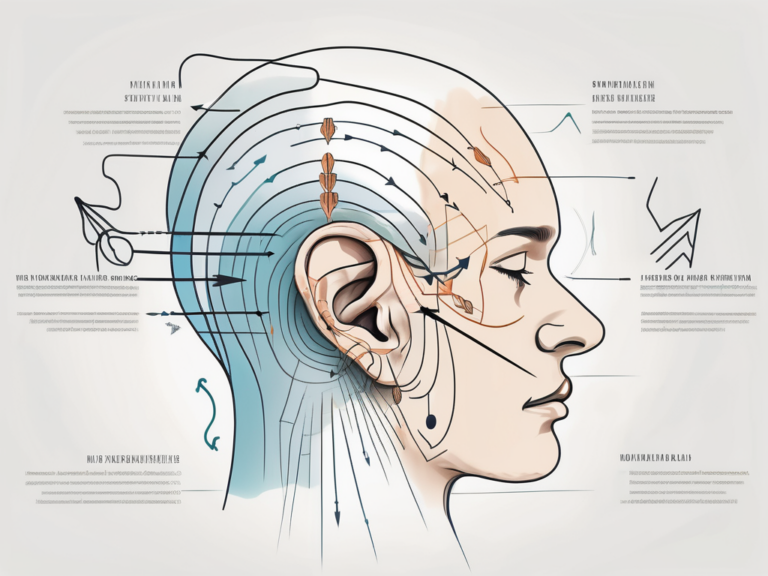What Is Recursive Thinking: A Comprehensive Guide
Recursive thinking is a cognitive process that plays a crucial role in problem-solving, creativity, and innovation. This comprehensive guide aims to provide a thorough understanding of recursive thinking, its importance in various fields, techniques for developing recursive thinking skills, a comparison between recursive thinking and linear thinking, and a glimpse into the future of recursive thinking.
Understanding the Concept of Recursive Thinking
The Basics of Recursive Thinking
Recursive thinking is a fundamental cognitive process that involves breaking down complex problems or tasks into smaller, more manageable parts. At its core, recursive thinking revolves around the idea of solving a problem by applying the same procedure or algorithm repeatedly to solve smaller sub-problems. By breaking down a problem into smaller components, recursive thinking allows for a systematic and efficient approach to finding solutions.
When engaging in recursive thinking, individuals often start with a larger problem and then identify smaller, more manageable sub-problems that need to be solved. These sub-problems are typically similar in nature to the larger problem, but on a smaller scale. By solving these smaller sub-problems, individuals can then combine the solutions to obtain the solution to the original, larger problem.
The Science Behind Recursive Thinking
Recursive thinking stems from the concept of recursion, which is deeply rooted in mathematics and computer science. In mathematics, recursion refers to a method of defining functions or sequences in terms of themselves. This concept allows for the creation of programs that can solve problems by repeatedly applying a well-defined set of rules or instructions.
In computer science, recursion is a powerful technique used in algorithms, data structures, and other areas of computational problem-solving. It enables the development of efficient algorithms by breaking down complex problems into smaller, more manageable sub-problems. This approach not only simplifies the problem-solving process but also enhances the overall efficiency and effectiveness of the solution.
Furthermore, recursive thinking is not limited to mathematics and computer science. It can be applied to various domains, including problem-solving in everyday life. By embracing recursive thinking, individuals can tackle complex challenges by breaking them down into smaller, more manageable tasks. This approach promotes a structured and systematic way of thinking, leading to more effective problem-solving strategies.
The Importance of Recursive Thinking
Recursive thinking is a powerful cognitive tool that offers numerous benefits in problem-solving. By breaking down complex problems into smaller sub-problems, individuals can navigate through the intricacies of the challenge with greater ease and efficiency. This methodical approach enables a deep understanding of the problem at hand and facilitates the discovery of innovative solutions.
When faced with a complex problem, it can be overwhelming to tackle it as a whole. However, by employing recursive thinking, individuals can focus on solving each component separately, gradually building up to the larger problem. This approach not only simplifies the task at hand but also allows for a more comprehensive analysis of each sub-problem. By delving into the details of each component, individuals gain valuable insights that can be applied to the overall problem-solving process.
Moreover, recursive thinking encourages the development of algorithmic thinking, which is becoming increasingly essential in today’s rapidly advancing technological landscape. Algorithmic thinking involves breaking down problems into a series of logical steps, much like the recursive approach. By honing this skill, individuals can approach complex problems with a structured and systematic mindset, leading to more efficient and effective problem-solving.
But the benefits of recursive thinking extend beyond problem-solving alone. This cognitive tool also plays a pivotal role in fostering creativity and innovation. By exploring multiple iterations of a problem and its solutions, individuals can uncover new perspectives and possibilities. This iterative approach opens doors to unconventional ideas and enables individuals to think beyond the confines of linear thinking.
Recursive thinking encourages the exploration of different paths, leading to novel and innovative solutions. It challenges individuals to question assumptions, push boundaries, and consider alternative approaches. By embracing this mindset, individuals can tap into their creative potential and discover groundbreaking solutions that may have otherwise remained hidden.
In conclusion, recursive thinking offers a multitude of benefits in problem-solving and beyond. By breaking down complex problems, individuals can gain a deeper understanding and find innovative solutions. Furthermore, recursive thinking fosters creativity and innovation by encouraging the exploration of different perspectives and possibilities. So, the next time you encounter a challenging problem, remember the power of recursive thinking and embrace the opportunity to think outside the box.
Recursive Thinking in Different Fields
Recursive thinking, with its ability to break down complex problems into simpler, self-referential components, has found its way into various fields, including mathematics and computer science. Let’s delve deeper into these two domains to explore how recursion has become an indispensable tool.
Recursive Thinking in Mathematics
In the realm of mathematics, recursive thinking has long been a fundamental approach. It allows mathematicians to unravel intricate patterns and phenomena by expressing them through simple, recursive formulas. One notable example is the Fibonacci sequence, where each number is the sum of the two preceding ones. This recursive definition not only generates a sequence of numbers but also reveals the inherent mathematical beauty behind it.
Moreover, recursion extends its reach beyond sequences. It plays a pivotal role in recursion theory, a branch of mathematical logic that investigates the limits and possibilities of computation. Concepts like the halting problem, which explores the ability to determine if a program will halt or run indefinitely, rely heavily on recursive thinking. By breaking down complex problems into smaller, self-referential parts, mathematicians can gain profound insights into the nature of computation itself.
Recursive Thinking in Computer Science
In the world of computer science, recursive thinking is not just a tool but a way of life. It forms the backbone of numerous algorithms, data structures, and programming paradigms. Recursive functions, in particular, are invaluable when dealing with problems that exhibit self-similarity or involve traversing intricate data structures.
By employing recursion, programmers can elegantly solve problems that would otherwise be arduous to tackle. For instance, in graph theory, recursive algorithms like depth-first search enable efficient traversal of complex networks. Similarly, recursive data structures like trees and linked lists provide a flexible and intuitive way to represent hierarchical relationships and interconnected data.
Furthermore, recursion enables programmers to embrace the divide-and-conquer strategy, where a complex problem is divided into smaller, more manageable subproblems. Each subproblem is then solved recursively, and the solutions are combined to obtain the final result. This approach is particularly useful in sorting algorithms like merge sort and quicksort, where the recursive breakdown of the problem leads to efficient and elegant solutions.
As we can see, recursive thinking transcends the boundaries of mathematics and computer science, permeating various fields. Its ability to break down complex problems into simpler, self-referential components has revolutionized the way we approach and solve challenges. Whether it’s unraveling the mysteries of the Fibonacci sequence or designing efficient algorithms, recursion continues to be an indispensable tool in the quest for knowledge and innovation.
Developing Recursive Thinking Skills
Techniques for Cultivating Recursive Thinking
Developing recursive thinking skills requires practice and certain techniques. One such technique is breaking down complex problems into smaller, more manageable sub-problems. By solving these sub-problems, individuals gradually build their recursive thinking abilities. This approach allows for a deeper understanding of the problem at hand and enables the development of creative solutions.
Another effective technique for cultivating recursive thinking is analyzing existing recursive solutions and studying recursive algorithms. By examining how others have approached and solved recursive problems, individuals gain valuable insights and learn new strategies for tackling similar challenges. This process not only enhances their understanding of recursion but also expands their problem-solving repertoire.
Furthermore, engaging in collaborative problem-solving activities can greatly contribute to the development of recursive thinking skills. Working with others who have different perspectives and approaches can expose individuals to a variety of recursive problem-solving techniques. This exposure fosters a more comprehensive understanding of recursion and encourages the exploration of alternative solutions.
Challenges in Learning Recursive Thinking
While recursive thinking is a valuable skill, it can present challenges for learners. One common challenge is grasping the concept and application of recursion itself. Understanding how recursive functions call themselves and when to stop the recursion can be initially perplexing. However, with patience and practice, individuals can overcome this hurdle and begin to appreciate the elegance and power of recursive thinking.
Additionally, identifying appropriate base cases, or stopping conditions, is crucial to avoid infinite recursion. Determining when to terminate the recursive process requires careful consideration and an understanding of the problem’s requirements. Through exposure to different recursive problems and guided practice, learners can develop the ability to recognize and define suitable base cases.
Moreover, another challenge in learning recursive thinking is applying it to real-world scenarios. While recursive thinking is often used in computer science and mathematics, its practical applications can extend beyond these fields. Encouraging learners to explore and identify real-world problems that can be solved using recursive thinking can help bridge the gap between theory and application.
In conclusion, developing recursive thinking skills is a process that requires practice, exposure to different problem-solving techniques, and a willingness to embrace challenges. By breaking down complex problems, analyzing existing solutions, and engaging in collaborative problem-solving, individuals can enhance their recursive thinking abilities. While there may be challenges along the way, with perseverance and a growth mindset, learners can unlock the full potential of recursive thinking and apply it to a wide range of problems.
Recursive Thinking vs. Linear Thinking
Key Differences and Similarities
Recursive thinking stands in contrast to linear thinking, which follows a sequential, step-by-step approach. While linear thinking is useful for many situations, recursive thinking is more suitable when dealing with complex problems that can be broken down into smaller sub-problems. Recursive thinking allows for an iterative process, repeatedly applying the same procedure to solve sub-problems until the entire problem is solved. Linear thinking, on the other hand, may lack the depth and efficiency that recursive thinking provides.
Choosing the Right Approach
Selecting the appropriate thinking approach depends on the nature of the problem at hand. Linear thinking is often more intuitive and straightforward, making it suitable for simpler problems. However, when faced with intricate or complex problems that require breaking down into smaller parts, recursive thinking becomes the optimal choice. Understanding both approaches and their strengths allows individuals to adapt their thinking strategies accordingly.
Let’s delve deeper into the concept of recursive thinking. It is like peeling an onion, where each layer represents a sub-problem that needs to be solved. By breaking down complex problems into smaller, more manageable parts, recursive thinking enables individuals to tackle the challenges with a systematic and organized approach. This approach allows for a deeper understanding of the problem at hand, as it encourages individuals to explore different perspectives and potential solutions.
On the other hand, linear thinking may lack the depth and flexibility that recursive thinking offers. While linear thinking follows a linear progression, moving from one step to the next, recursive thinking allows for a more dynamic and iterative process. It encourages individuals to revisit and refine their solutions, constantly improving and optimizing their approach. This iterative nature of recursive thinking promotes creativity and innovation, as it allows for the exploration of multiple possibilities and alternatives.
When faced with a problem, it is crucial to consider the advantages and limitations of both recursive and linear thinking. Linear thinking may be more suitable for straightforward problems with clear and well-defined steps. It provides a structured and logical approach, ensuring that each step is completed before moving on to the next. However, for complex problems that require a deeper analysis and the ability to break them down into smaller components, recursive thinking becomes invaluable.
Recursive thinking enables individuals to see the bigger picture while simultaneously focusing on the details. It encourages a holistic approach, where each sub-problem is solved in relation to the overall problem. This interconnectedness allows for a more comprehensive and effective solution, as it takes into account the interdependencies and relationships between different parts of the problem.
In conclusion, both recursive and linear thinking have their place in problem-solving. Understanding the strengths and weaknesses of each approach allows individuals to adapt their thinking strategies accordingly, ensuring that they can tackle any problem with confidence and efficiency.
The Future of Recursive Thinking
Recursive thinking, a cognitive process that allows individuals to tackle complex problems by breaking them down into smaller, more solvable components, is poised to shape the future of various fields, from mathematics to computer science. As technology continues to advance, recursive thinking is playing a vital role in the development of artificial intelligence (AI) and education.
In the realm of AI, recursive algorithms and techniques are enabling machines to process and analyze vast amounts of data, recognize patterns, and make informed decisions. By applying recursive thinking, AI models can continuously improve their performance over time, leading to more sophisticated and capable AI systems. This iterative approach allows AI to adapt and learn from its experiences, mirroring the way humans learn and evolve.
However, the impact of recursive thinking extends beyond AI. In future education, recursive thinking is set to become imperative. By fostering recursive thinking skills from an early age, educational systems can better prepare students for the ever-changing world. Recursive thinking encourages critical and analytical thinking, enhances problem-solving abilities, and nurtures creativity and innovation.
When students are equipped with recursive thinking skills, they can navigate complex challenges with ease and contribute meaningfully to society. By incorporating recursive thinking into curricula, educational institutions can empower learners to approach problems from multiple angles, encouraging them to explore different solutions and think outside the box.
Developing recursive thinking skills requires practice and a deep understanding of recursive concepts. While recursive thinking differs from linear thinking, both approaches have their place in problem-solving. Linear thinking is valuable for tackling straightforward, linear problems, while recursive thinking excels in addressing complex, interconnected problems.
As we look to the future, recursive thinking continues to shape the landscape of artificial intelligence and education. Its importance cannot be overstated, as it offers limitless possibilities for innovation and progress. By embracing recursive thinking, we can unlock new frontiers in AI development and equip future generations with the skills needed to thrive in an increasingly complex world.






